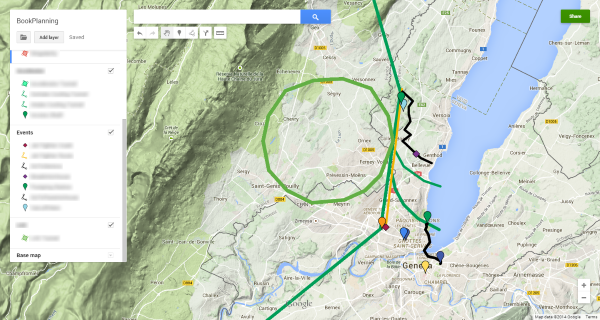One of the biggest problems to tackle when writing a novel is keeping places and times consistent and believable, especially if you have set it on Earth at present day. There are several things to consider, and I’ll name just a few:
- places where things happen should be real (or realistic)
- travel times must match actual terrain, urban, and political conditions
- the style and feeling of urban landscapes should match what’s really out there.
You might be tempted to ask, why can’t I just make it all up?
Because the reader would know, and your work would sound fake – not just fictional. Not all of your readers know everything about the places you’re describing, but in today’s world everyone knows at least something about most places. You know, the Internet. It certainly is a superficial knowledge, maybe even stereotypical, but we all have it.
Enter Google Maps Engine.

My next novel is set in Geneva, and from the signs on the map you can certainly guess what’s involved. Now, I’ve never been there, but Google Maps and Street View came to my rescue (these are wonderful times).
But what can you do with Google Maps Engine?
First of all it’s free, then it’s also very polished, and everything is saved automatically (quite obviously, given that we’re talking about Google).
- You can add pins on a map, draw lines and get their length, and draw closed polygons to get their perimeter and area. This is very useful because you can plan journeys, pin important places, and check distances to avoid that one of your characters believes to be taking a short stroll downhill, while in truth she’s running a marathon up a mountain and across a closed border.
- You can set colors and shapes, and GME also supports layers, so you can toggle on and off parts of your scheme when it starts getting a little cramped.
- You can switch between several map modes, most importantly simple map, satellite, and terrain.
Nothing’s perfect, and I miss Street View in GME. Not too bad, you can fall back to regular Google Maps for that. Also, you can’t draw basic geometric shapes like rectangles, circles, and so on. Instead, you must draw connected segments. The result is a little rough but it gets the job done.
I discovered this hidden treasure a bit too late, when the first draft was done already, but just in time to check everything, and find and fix several issues, one of which was rather gross.
What about you? Have you ever used this or other tools to get the geography right in your fiction?
